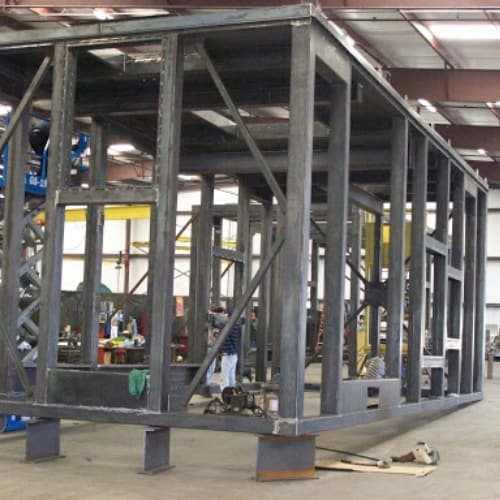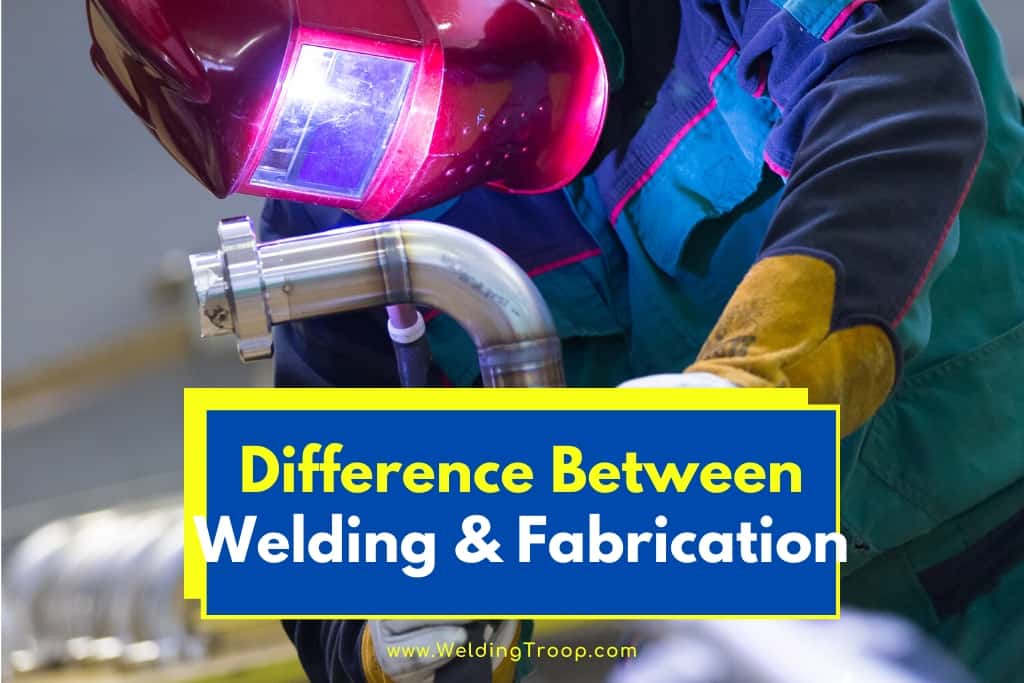Human beings are great problem solvers. The ability to create buildings, structures, or even smaller parts of a machine is the result of the fabrication process. From airfields to sheds, the creation of structures to shelter and suit our lifestyles undergo some sort of fabrication to reflect the innovation that went into their creation.
What is the difference between welding and fabrication? Fabrication is the entire process of creating metal from beginning to end. In contrast, welding is only one part of the fabrication process, which involves using heat to join two pieces of metals together.
The remainder of this article will discuss fabrication and welding in detail, including what is all involved with each process.
Table of Contents
Why is Metal Fabrication Essential?
Metal gives structural strength and efficiency. For instance, metal is strong and gives longevity to structures. However, despite its strength, it is easily manipulated and bent to take on a new shape. Furthermore, due to its strength, it is incredibly cost-efficient. Fabricators can replicate the procedure to create a product, which brings down the cost per unit.
Also, metal is cost-efficient for the owners. Buildings or structures that utilize the fabrication process have a lower risk of fire damage, peeling paint, and even attract fewer pests. Best of all, its resistance to damage means there are lower insurance rates.

Related reading: How to Start & Grow A Welding Business In 11 Steps
The Fabrication Process
Fabrication is the process of bringing together steel parts and assembling, or fabricating, something out of the parts. Typically, it is used to create steel structures, machines, buildings, or other components.
Since welding is only one step of the process of fabrication, it is helpful to understand the entire fabrication process.
Bidding on the Job
Every project begins with a bid for the work. The specific expectations of a job are stated in a detailed manner. Afterward, building companies will evaluate the job and whether they have the capabilities to take it on. Companies who feel confident to take on the scope of a project will bid on the job. Each bid considers the price for the job without sacrificing quality. One company will have a winning bid and will begin the project.
Planning Process
Before any fabrication or welding happens, there is a lot of time invested in the planning process. Typically, designers will work with engineers during this phase of the process. The goal is to get input from everyone since all members of this team have a unique set of skills. The planning team develops the right combination of building materials and what techniques are necessary to make it happen.
Raw Materials Take a New Shape
At this point in the process, the decisions are made, and it is time to produce a product. During this production, the raw materials are transformed from their standard stock shape and cut, bent, and changed into a product useful for building.
The fabricating team handles the most important pieces first, and those pieces need to be put together; this is where welding comes in.
The Role of Welding in Fabrication
A welder has a very specific job in the fabrication process. A welder will join two pieces of metal where they touch one another. This practice fuses them into one piece. It may sound simple, but it a highly specialized job.
Welders must prepare joints before welding. The edges need to be shaped and cleaned to allow fusing. Also, the pieces need to be arranged beforehand. The metal expands and contracts, so putting it all together with the right spacing of gaps is critical to the process.

During fabrication, there are a couple of main welding processes typically seen, such as fusion welding, which is the heating of metal and fusing them with a filler. Solid-state welding, which is also used in fabrication, works similarly but does not use a filler. Other welding options used include:
- Gas metal arc welding is a wonderful choice for sheet metal.
- Shield metal arc welding is very common in the fabrication process as it is a fusion method.
- Oxy-acetylene welding uses electric current and oxygen as well as acetylene through a torch nozzle.
- Tungsten inert gas welding is a refined process that uses a tungsten electrode to create a high-quality weld.
There are more welding options, but these are the most common during fabrication.
Related reading: 9 Different Types of Welding Processes & Their Advantages
The Fabrication and Welding Team
Metal fabrication relies on the skills of several people to make sure the projects are completed from the moment the bid is made until the final product is produced. Fabricators and welders are essential members of the team, but it takes a few more members to ensure success.
- Supervisors are responsible for overseeing the fabrication process. This oversight means the work is done in an organized manner, and quality is not sacrificed.
- Engineers set the standards and predict the performance of the final product. Usually, there are structural, chemical, and mechanical engineers involved with fabrication.
- Ironworkers source and prepare the steel when it is still iron.
- Machinists are vital because they operate the complex machines that take metal and create useable parts.
- Designers take what the engineers create and turn that concept into instructions for the rest of the team to use while in fabrication.
Related reading: How to Become a Certified Welder in Pennsylvania?
Main Types Of Welding Processes
We have 9 main types of welding processes. I recently wrote an in-depth article listing the 9 types of welding processes and their advantages here :
- Mig Welding
- Tig Welding
- Flux Cored Arc Welding
- Submerged Arc Welding
- Stick Shielded Metal Arc Welding
- Thermic Welding
- Oxyacetane Welding
- Forge Welding
- Resistance Welding
| Number | Welding Process | Description |
|---|---|---|
| 1 | MIG – Gas Metal Arc Welding (GMAW) | Also called Metal Inert Gas Welding (MIG). Provides the most consistent weld results. Some feel this is probably the easiest place to start for beginners. |
| 2 | TIG – Gas Tungsten Arc Welding (GTAW) | Also called Tungsten Inert Gas Welding (TIG). One of the neatest (cleanest) types of welding because it doesn’t create splatter. |
| 3 | Flux Cored Arc Welding (FCAW) | A great solution for tanks, boilers, and pipes that have thick plate metal. |
| 4 | Submerged Arc Welding (SAW) | Hot materials don’t splash, or splatter and the flux keeps high levels of radiation from escaping into the air. |
| 5 | Stick – Shielded Metal Arc Welding (SMAW) | This is also known as Stick Welding. It doesn’t require the gas shielding that TIG and MIG require and is very portable. It also works great outdoors for gates farm machinery, etc. |
| 6 | Thermit Welding | Allows for the fast joining of two dissimilar metals without requiring a power supply. |
| 7 | Oxyacetylene (Gas) Welding | Easy to learn and perform as well as being a low-cost solution. |
| 8 | Forge Welding | Best option for blacksmithing. |
| 9 | Resistance Welding | Is able to translate to very thin metals (0.1 millimeters) to this metals (20 millimeters). |
What Tools Are Required for Fabrication and Welding?
Fabrication and welding are specialized occupations, and the tools necessary for the projects are also complex. There are overlapping tools used in both welding and fabrication, but there are differences. A welder will use tools that join metals, while a fabricator will use tools that shape metals by cutting and bending. In addition, welders, in contrast with fabricators, apply heat to do their jobs, while fabricators do dry bending and cold rolling.
These are some of the tools you might find in a welding and fabrication shop:
- Computers and software
- Chipping hammers
- Angle grinders
- Wrenches
- Abrasives
- Laser cutters
- Water cutters
- Shears
- Vices and grips
- Welding clamps
- Oxygen tanks
- Acetylene tanks
- Mechanical saws
- Torches
- Consumable electrodes
- Welding helmets
- Tungsten inert gas consumables
For an interesting video showing the fabrication and welding process of an item, check this out. (Time lapse Tank Fabrication)
Safety is Essential
Any fabrication shop with welding is incomplete without safety equipment, no matter if you are a fabricator or a welder. Metal is sharp and heavy, and the metal can get hot.
Eye protection is a must in this environment, as are face shields. Furthermore, according to Michigan State University’s training documents titled “Respiratory Safety in the Steel Fabrication Industry,” respirators are necessary to avoid hazards such as fumes, aerosols, and vapors.
Related Article: Personal Protective Equipment for Welders – PPE | List, and Requirements
In Summary
From tools to cars and large buildings, fabricated metal is used everywhere. There is an entire process of fabricating metal. This process involves many different people, from designers to welders, who have the skills to work together to ensure a project is finished with the desired outcome.
Fabrication is the process of taking metal raw materials and creating something new with them. It involves planning the design of the overall piece and then working as a team to put it all together.
Welding is one part of the metal fabrication process that involves joining two pieces of metal to create a smooth seam between them. Welding requires a tremendous amount of skill and expertise to perform, so only highly qualified welders will be found on a fabrication team for multiple projects.
Related reading: Is Welding a Hard Job? | All Facts You Need To Know
By the end of the fabrication process, thanks to the skillset welders and their fabrication team bring to the projects, the result is a strong, durable, and cost-effective product.

